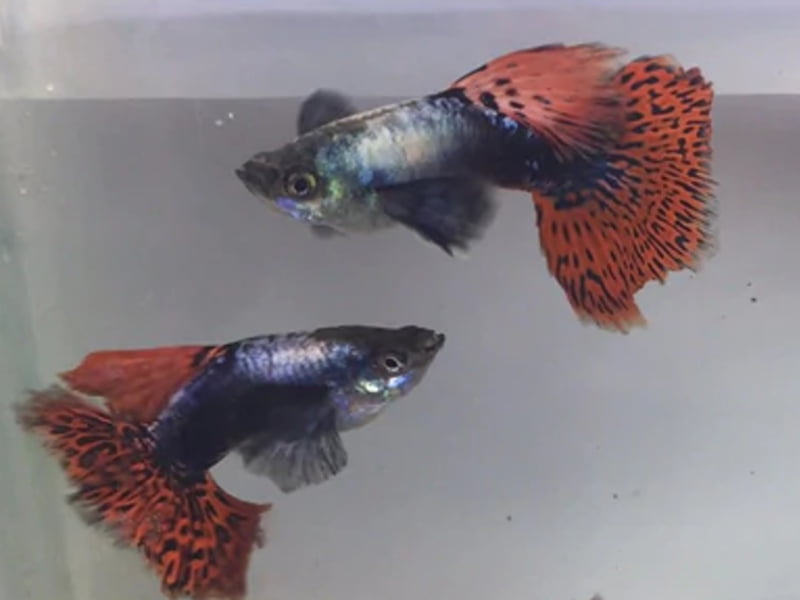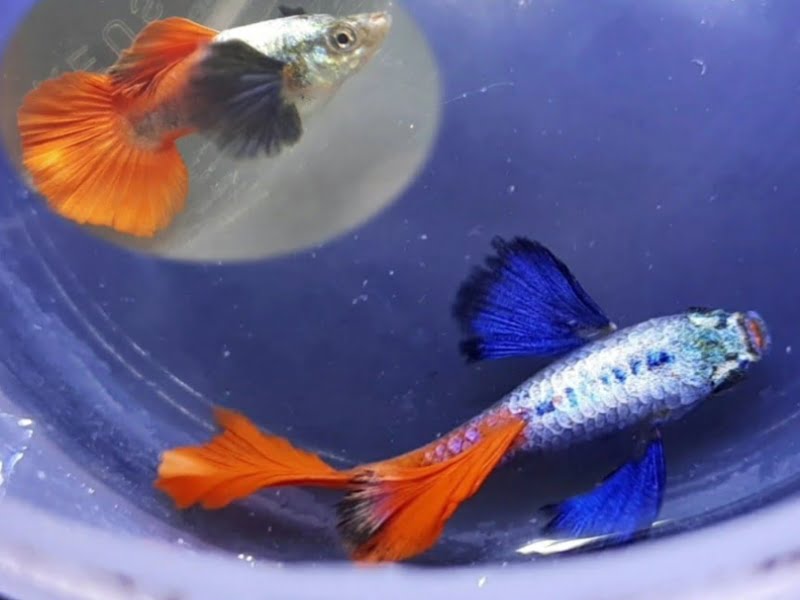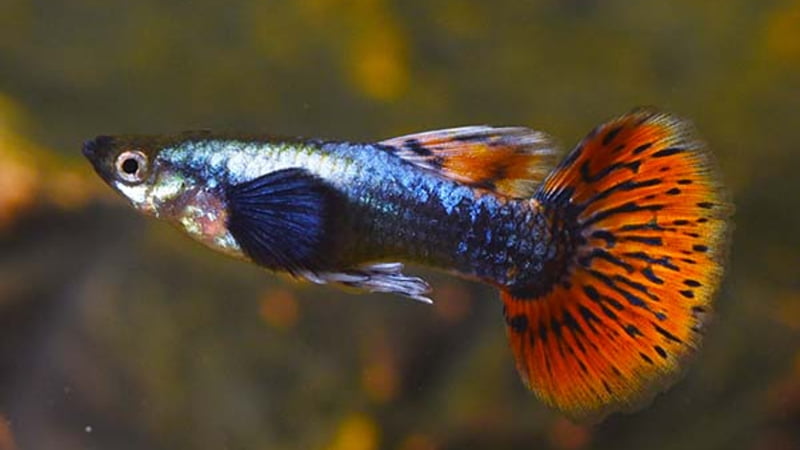Where do Dumbo guppy fish get their name from? What do they look like, and is this breed rare? I will give you all the answers. There are 3 things you need to know when it comes to identifying and taking care of Dumbo guppies: their appearance, their needs, and where to get them. Don’t miss the chance to learn how easy it is to care for this breed, even for beginner hobbyists.
Characteristics Of Dumbo Guppy Fish
Guppies are generally flashy fish. Even the females are impressive-looking with beautiful colors. You can find out now what the Dumbo breed looks like and its behavior.
Flashy Appearance
Dumbo guppies are famous for their giant pectoral fin that grows bigger alongside the fish’s bodies. Hence the name of this breed because the fins resemble Dumbo the elephant’s big ears. These guppies are pretty colorful as well. They mostly come in a mixture of different specks in blue, black, orange, purple, and sometimes green.
The best thing that I like about this breed is that both the females and males are colorful. And if we keep 1 male with 2-3 females in the tank, they will breed young fries that are just as colorful.

Behavior
Female guppies can get aggressive during pregnancy. They also eat the young fries following birth if aquarists don’t provide an adequate amount of food. However, they’re significantly more friendly than males. Males even battle to the end for the chance to mate with female guppies.
Lifespan
Guppies’ average lifespan is around 2 years, so it’s quite short compared to other community fishes. In order to prolong a Dumbo guppy’s lifespan, one must provide it with a healthy living condition where the tank is big but not crowded. The diet must contain both live food and sometimes vegetable, and the water temperature and pH level should always be correct. I will elaborate further below on how to take care of dumbo guppy fish.
Male Vs Female
Even though guppies are peaceful fish, they can still get violent when there are aspects in their living environment that don’t seem right to them. For example, if there are too many male guppies with few females, a blood bath ensues. The male will fight each other to the point where their fins are damaged, the stress level is high, and some might even die from being injured.
Female guppies can get violent as well when they are pregnant or stressed. They will feed on their fries after giving birth if the tank or birthing space is too small. This is a common phenomenon among female guppies, so don’t be shocked when you see it for the first time. My advice is to separate the pregnant female from the young soon after giving birth.
How To Take Care Of Dumbo Guppy Fish
Taking care of a Dumbo guppy isn’t complicated at all. This species is perfect for even beginner aquarists. All you have to worry about are its diet, tank condition, and hiding spots.

Diet
Dumbo guppy fish or any other guppy take in different kinds of food that range from plant-based to tiny little larvae. They can eat baby brine shrimps, mosquito larvae, and so on. They can also feed broccoli or cauliflower that you drop into the tank. Just make sure to remove the leftover to avoid contaminating the water quality. Guppies eat twice per day, and they prefer live food to vegetables.
Also, if you want your Dumbo guppies to become more colorful over time, you should feed them flake food with high protein and vitamins.
Tank Size And Condition
Because they are tropical fish, guppies prefer living in warm water temperatures ranging from 75 to 82 degrees F, which requires a heater for stable heat. The pH should be around 7, and water hardness should be about 10-30KH—guppies like living in hard water.
What number of guppies fits in a tank that holds 10 gallons? A mature guppy measures around 2 inches in length, which is small compared to other fish species in the community. For a tank of 10 gallons, you ought to be able to keep up to 4-5 guppies. I would not recommend keeping more because an overcrowded tank will need more maintenance, and the tank members will feel more stressed.
Plants (Real Or Artificial)
It’s important not to leave the tank bare without any decoration because this has a protective meaning. Young fries often become food for their mother when they aren’t big enough to not fit in her mouth anymore. That’s why when they are still too young and food-like, they need some decorations like real or fake plants to hide.
The same goes for weak male guppies that dominant ones bully. They need hiding spots with many layers of leaves to avoid sudden attacks and have time to heal peacefully. “Peace” is an essential requirement for aquariums.
Where To Buy Dumbo Guppy Fish
Dumbo guppy fish are quite rare and there aren’t many big pet stores that sell this breed. You can find some on COAST GEM USA or Live Aquaria. They ship live fish to your doorsteps. If you want to purchase a Dumbo guppy on the spot, my best suggestion is to find a local breeder. They usually care more for the health of the fish, and you can pick one according to your preference and critique on the spot.
Video: Giant Dumbo Ears On Guppy Keeps Growing!
FAQs
How often do guppies need to be fed?
Feed adult guppies once or twice every day. At least one meal must comprise fresh food. Healthy adult guppies can live without food for about 2 weeks. They can also consume algae in tanks in the absence of food. However, it’s vital to provide them with live food such as baby brine shrimps and mosquito larvae for them to thrive.
How big do dumbo guppies get?
Dumbo guppies are pretty small, and the females are usually bigger than the males. On average, an adult Dumbo guppy reaches 2.5 inches in length. A female can develop further up to 3 inches. Bigger guppies are rare. In fact, I haven’t spotted a bigger Dumbo guppy than the average size.
Are female guppies colorful?
Yes, female guppies are colorful. But they usually aren’t as creative-looking and vibrant as the males.
Are dumbo guppy fish rare?
Dumbo guppies have unique pectoral fins feature and assorted body colors, which makes this breed an absolute beauty, and more or less rare, but not too rare. You can still encounter this species in many online stores. But to find a healthy one with a beautiful color mixture is not an easy task.

Annette M. Chaney is an experienced marine biologist with over 20 years of experience as an aquarist and fishkeeper. She started her first aquarium at a young age, filling it with frogs and goldfish obtained from the ten-cent pet store.
Annette grew up caring for and breeding African Cichlids, which led to a hobby in high school that doubled as a profitable means. Attending Reed College gave her time to solidify herself as an accomplished aquarium caretaker with an eye for sales. After that, from 2009 – 2013, she studied at Roger Williams University – one of the most prestigious universities for Aquaculture and Aquarium in USA. She is the founder of AquariumCircle since 2010.
